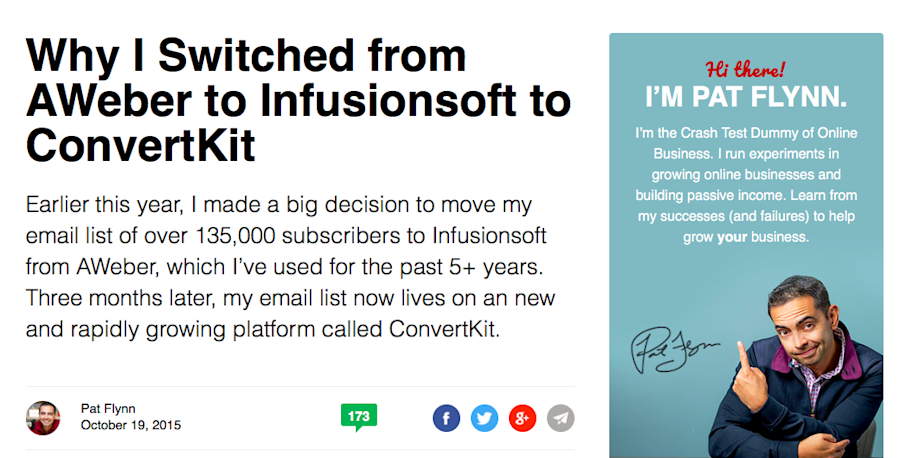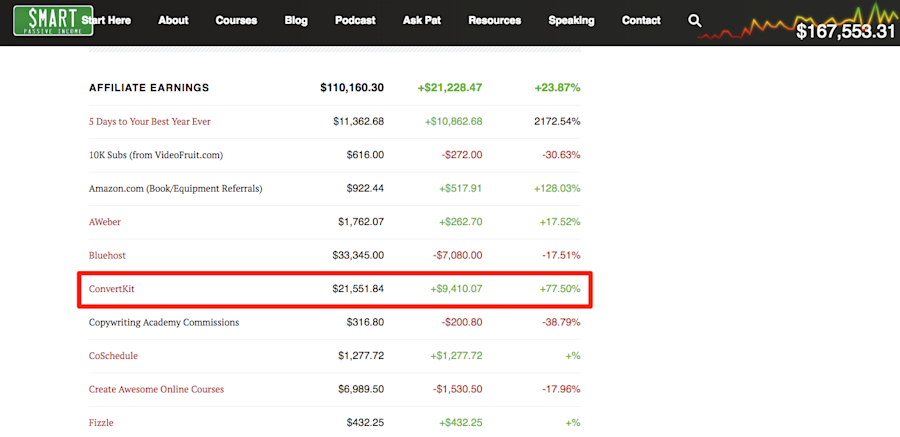In January of 2016, two friends on an annual ski trip had an unexpected conversation.
Those friends were Darrell Vesterfelt and Nathan Barry.
At the time, Darrell was helping other bloggers monetize their digital platforms. And Nathan was the founder of ConvertKit, an email marketing platform built specifically for professional bloggers.
“Nathan and I had this epic 4 or 5-mile walk outside of Breckenridge, brainstorming what it might look like to work together,” Darrell told us during a recent Skype interview. “At the end of the walk, we just kept circling the block, talking about our ideas.”
ConvertKit was three years old and was generating $70-80k a month in revenue. It had grown pretty much organically — promoted by word of mouth, especially by influential bloggers.
No one at ConvertKit had solely focused on growth, which is what, on that cold walk in January, the two friends decided Darrell would do.
Darrell’s goal after taking the job?
Finding one thing he could focus on to grow ConvertKit’s user base and monthly revenue.
That one thing — as it turned out — was webinars presented in partnership with ConvertKit affiliates.
What follows are Darrell’s hard-earned insights and the step-by-step approach he used to help ConvertKit grow monthly revenue from $98k to $625k — in just 12 months, by placing the majority of his focus on webinars.
(Note: If you’re using strategies like partnership webinars to grow traffic, you can use our tool, Leadfeeder to see who that traffic includes, even if they never fill out a single form. Try it free in minutes.)
The Early-Stage Secret: Find One Thing That Generates Growth
“Early on, you don’t need five marketing strategies,” Darrell told us. “You won’t do any of them well. You need one growth strategy that works, and you need to do it over and over and over again until it stops working or until you’re big enough that you can hire a team to do multiple things.”
ConvertKit was early-stage and bootstrapped, so they had to stick to low-cost strategies.
Darrell explained, “We couldn’t necessarily afford to spend money on Facebook ads to drive leads the way that other companies were. But I had time.”
ConvertKit’s marketing strategy included more time consuming, but cost-effective tasks including content marketing and direct sales, but focused the most energy on webinars.
Webinars were cheap to run, and they naturally built a community around a relatively new product. They were also the first thing Darrell found that consistently produced new signups.
So, he stuck with it.
“We’re so new,’ Darrell remembers thinking. “We can go all in on this one thing and see massive growth in the next twelve months. And so the goal then was to book as many webinars as possible with no limitations.”
And that’s what he did.
He gave the same webinar over and over — but hosted by different partners, mostly from their affiliate program.
Darrell hosted more than 150 in the first year. That’s 20-30 webinars a month — sometimes two to three webinars a day.
It was exhausting at times. But it worked.
As a result, ConvertKit saw a 637% growth in monthly revenue.
How ConvertKit Ran Successful Partner Webinars
1. They maintained a wide open affiliate program
The first key to ConvertKit’s successful webinar strategy was its wide-open affiliate program.
People didn’t have to apply to become a ConvertKit affiliate (it’s common for companies to require affiliates to apply and be approved — a practice Darrell has never understood).
All affiliates needed to do was sign up. Then they earned a recurring 30% commission for the life of the customer.

As an ideal affiliate program should, ConvertKit’s program created loyalty and helped their customers grow with the company.
“We had like 13,000 customers and 4,000 affiliates. It was part of our new customer drip. Everyone who signed up got a chance to be an affiliate.”
2. They would do a webinar with any affiliate—no matter how small the audience When someone signed up to be a ConvertKit affiliate, it didn’t matter if they had 100 followers or thousands — ConvertKit would send an email asking if they’d like to host a webinar.
“Most people focus on getting 15 Pat Flynns to do the webinars. I didn’t do that. The other thing was, I didn’t know who the next Pat Flynn was.”
That’s not to say that Darrell didn’t also target people with huge audiences — like Pat Flynn of Smart Passive Income, who did one of the first partner webinars with Darrell. It helped that Pat was already a fan of the service.

“We booked Pat Flynn in the first quarter of my first year. Some crazy amount of people … like a thousand people in 24 hours signed up for ConvertKit after that webinar.”
It was a big win for ConvertKit, and the exposure extended beyond the webinar itself.
Darrell used the success of the big webinars like Pat’s to capture the interest of other influential bloggers.
Because Pat publishes detailed monthly income reports, Darrell knew people would see how well the webinar did without much additional promotion.

3. They gave away hundreds of dollars of value during the webinar — and asked for nothing in return
In 2016, it seemed like everyone had a webinar you could attend — especially in the marketing world. Most were nothing but thinly veiled sales pitches for a product or service.
As a result, the market was a little burned out on webinars, a fact Darrell used to his advantage.
“Because we were jaded too, we knew we could position ourselves against that jadedness, and say, ‘We’re actually going to teach you.”
Darrell directly addressed people’s jadedness to webinars in the webinar itself.
“I would say something along the lines of, ‘You know how webinars usually go. You’re on here for like 20 minutes and somebody asks you to spend a thousand dollars on some course that you don’t want or need.’ I would literally say that every single time to win the trust right out the gate. ‘Here’s my promise to you. I’m not going to ask you to spend a single dollar today.’”
Instead, he gave away online courses, ebooks, and t-shirts — and the affiliate partners often had freebies of their own.
One partner gave away an online course on how she used ConvertKit. Using her own account, she showed how to optimize the service. “It was really brilliant and helped the success of her leads a lot more.”
Darrell approached webinars as a long-term investment. He wasn’t looking for people to invest monetarily that day. Participants could try out ConvertKit free for a month, equipped with free courses and other information about how to get the most out of it.
Even if they didn’t use the free month, anyone who signed up for a webinar was a lead that entered into their sales funnel.
“In my first year we did a Black Friday promotion and it crushed. It crushed because we had all of these leads from webinars earlier in the year, and their first experience with us was generosity, and teaching. They weren’t jaded towards our brand because their first experience was, ‘Oh my gosh, ConvertKit just gave me $400 worth of free stuff and let me try out their software — no questions asked.”
4. They Maintained a Narrow Target Audience
Courses and webinars work best with a narrow audience. They can’t be for everyone.
Darrell believes that one of the biggest reasons for ConvertKit’s bootstrapped success was that it was a service specifically created for bloggers by bloggers.
“I was a blogger, Nathan was a blogger. Basically everybody who worked for ConvertKit at that time was a blogger. We knew how they thought, knew how they felt. They were our friends.”
It was scary narrowing their market and staking a claim specifically in the blogging community.
“But looking back, I think it was that thing that made us succeed more than anything else. And there were many times that we had talked like maybe we should broaden this, maybe we should expand our target market. I’m really glad that we didn’t — at least in this first two years — because it was the intimacy that we had with our people. We know you — because we are you and we’re only for you.”
He was able to choose a low-cost marketing strategy that worked because it’s what would’ve worked for him as a blogger. It’s what he would’ve wanted.
5. They Kept The Technology Simple
This is where Darrell believes so many early-stage companies go wrong. They get bogged down in high-cost technology with fancy features and lots of data points. Darrell’s motto was to keep it simple.
“At first we used Leadpages, YouTube Live, and Chatroll and that was it. We put it all together on one page, and would stream live through a Google Hangout type thing.”
About six months in, they switched away from Leadpages to a custom Wordpress page developed by an internal designer. They stuck with YouTube and Chatroll.
Out of 150 webinars, they had major tech issues only once — and that was when they were trying out more complicated software.
They managed promo links through an Affiliate program called Ambassador. The most complicated data they tracked were about their affiliates, which they used to run follow-up webinars for partners who had a lot of signups.
About the webinars themselves, they tracked only important data points.
“Everybody was saying we need X Y or Z data points, but in reality, what were we going to do with that information? At that point in the business, what am I going to do with the minute-by-minute breakdown of engagement of my webinar?” Darrell asked.
“I think a lot of people make mistakes early on when they try to replicate companies that are at different stages of business than them, or they just make things super complicated.”
Should You Replicate This Strategy?
Whether you’re trying webinars or something else, much of what worked for ConvertKit is relevant for any company looking to grow. Specifically:
Narrow your audience
Leverage other people’s networks (and make it easy to become an affiliate!)
Don’t hard sell on your first interaction
But the main point is: find your “one thing.”
Find that one thing you can do over and over to spur on growth.
Webinars worked for ConvertKit. For you, it might be something else.
Whatever strategy you choose, here’s what Darrell said when we asked what advice he had for early-stage marketers:
“Be addicted to simple”
It was advice Darrell received from Bryan Harris when he started at ConvertKit. He even wrote the quote on his computer to keep it in mind.
“We think that we have to do a bunch of complicated stuff to grow quickly and it’s just not true,” Darrell told us. “Momentum is a funny thing — complication can actually slow momentum down.”
By starting out with a simple strategy, he explained, “it actually sped up our momentum super fast — to a point where we could add other things into the mix when it was time, and it wouldn’t slow our momentum down.”
Now that you're here
Leadfeeder is a tool that shows you companies that visit your website. Leadfeeder generates new leads, offers insight on your customers and can help you increase your marketing ROI.
If you liked this blog post, you'll probably love Leadfeeder, too.
Sign up



